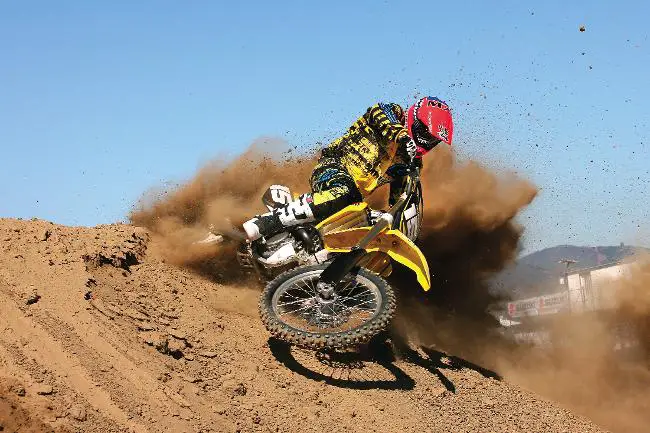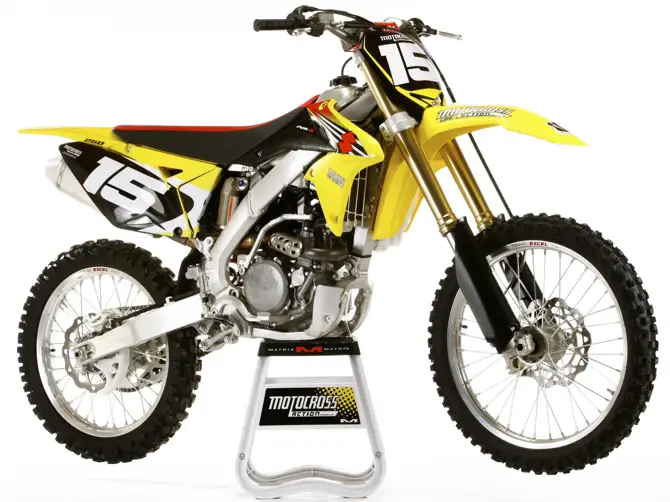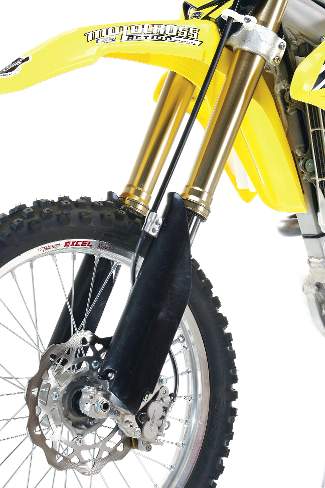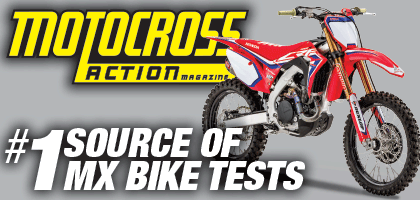MXA’S 2012 SUZUKI RM-Z250 MOTOCROSS TEST: IS IT JUST ANOTHER REHEATED 2011 MODEL?

Q: FIRST AND FOREMOST, IS THE 2012 RM-Z250 BETTER THAN THE 2011 RM-Z250?
A: That depends on who you ask. Our aesthetically focused test riders were enamored by the feng shui of the red stripe on the seat cover in relation to the red accents on the shroud graphics. They felt a calm sense of peace and tranquility while riding the 2012 RM-Z250, and thus believed that the 2012 model was better than the 2011 version. The colorblind MXA test riders didn’t experience any warm fuzzies.
All sarcasm aside, the 2012 RM-Z250 is the exact same bike as last year (the new seat cover, fuel-pump assembly and breather hose notwithstanding).
There is no performance difference between the 2012 model and its predecessor. Aside from the seat cover, black fork guards and graphics, not a single tester would have been able to differentiate between the two models (unless they studied the length of the breather hose).
Q: HOW MANY CHANGES WERE MADE TO THE 2012 SUZUKI RM-Z250?
A: We would be telling tales out of school if we said that the 2012 Suzuki RM-Z250 is new from the ground up. In fact, we’d be telling a white lie if we said that the bike was even slightly changed. A toddler could count the updates made to the 2012 RM-Z250 on a single hand. Without further ado, here’s the short and sweet list:
(1) Fuel-pump assembly. The liquid-level holding cover has been changed from rubber to resin. The lighter material equates to a weight savings of 23.7 grams (0.8 ounce). This is not a performance upgrade.
(2) Breather hose. The length of the breather hose has been shortened 80mm, and a hole has been added (resulting in a weight savings of 10 grams, or 0.35 ounce). A hose clamp has been added to the bolt on the right side of the intake pipe to improve the cable arrangement around the throttle body.
(3) Graphics. A red stripe extending the length of the seat cover, black fork guards and slightly updated graphics are the only telltale signs that the RM-Z250 is, in fact, a 2012 model.

2012 Suzuki RM-Z250: The only visual changes on the new bike are the black fork guards, graphics and red stripe running down the seat cover. Fortunately, the RM-Z250 was so good last year that it can still hold its own against the competition.
Q: WHY DIDN’T SUZUKI MAKE ANY CHANGES FOR 2012?
A: The short and sweet answer is that Suzuki made a grand total of 34 changes to the RM-Z250 for the 2011 model year. In essence, they did everything they could do the year before. Research and development costs a pretty penny (and money isn’t something that anyone, including the U.S. government, has a whole lot of these days). Suzuki weighed whether making some technical changes to the 2012 RM-Z250 would be offset by increased sales or whether it would just be money down the rabbit hole in a bad business climate.
Furthermore, the 2011 Suzuki RM-Z250 earned the prized distinction of being named “MXA‘s 250 Four-Stroke Shootout” winner. Aside from a few minor tweaks, the RM-Z250 was a winner right out of the crate last year. It makes sense that the 2012 model would be just as good. Essentially, Suzuki made a calculated decision that the RM-Z250 was the best bike of 2011?and that it might just be good enough in 2012.
 Screaming yellow zonker: Our 2012 RM-Z250 reached 38.12 horsepower on our dyno (identical to last year). This is a powerful engine, but it could stand to have more top-end.
|
Q: HOW WOULD WE DESCRIBE THE 2012 SUZUKI RM-Z250 ENGINE?
A: Suzuki released an all-new engine in 2010. Last year, Suzuki added an oil-transfer slot to the base of the cylinder, changed the shape of the cylinder-base gasket and changed the camshaft profile. These updates further improved engine performance. For 2012, Suzuki left the engine alone.
The old engine (that is to say the 2004??2009 engine) was the king of bottom-end hit. From 6000 to 8000 rpm, it couldn’t be matched by any other 250 four-stroke. Unfortunately, once the engine jumped into the midrange, the powerband plummeted faster than Charlie Sheen’s inhibitions at an open bar.
It took Suzuki’s engineers several model years to understand that the most important part of a 250 four-stroke powerband is mid-and-up, not low-to-mid. In 2010, Suzuki kicked out the jams and gave the RM-Z250 a much needed revamping. What was once a get-up-and-go-nowhere powerband transformed into a screaming, ripping, explosive engine bred for racing.
The 2012 engine isn’t altogether different from the 2010 model. That’s not a bad thing. Midrange power is plentiful, and the engine holds strong into the top end. While the low-to-mid grunt is gone, we’re pleased to find a more appropriate overall powerband in its place. The Suzuki RM-Z250 doesn’t have the most explosive or fastest engine on the track, but it’s an effective racing weapon in the hands of nearly every level of rider.
Q: HOW DOES THE 2012 SUZUKI RM-Z250 RUN ON THE DYNO?
A: Since the 2012 model didn’t receive any updates, it isn’t on the fast track to the stratosphere compared to last year’s model.
Compared to its competition, the 2012 RM-Z250 makes 38.12 horsepower, which is virtually identical to the 2011 RM-Z250’s numbers (although there was a slight improvement in over-rev?must be that breather tube).
All in all, the 2012 Suzuki RM-Z250 produces a very healthy number, albeit short of the class-leading Kawasaki KX250F’s 39.55 horses.
Q: WHAT IS THE GREATEST ATTRIBUTE OF THE 2012 SUZUKI RM-Z250?
A: For six straight years, the Suzuki RM-Z250 has had no equal in terms of cornering prowess. The aluminum frame blends a steep head angle with enough trail to create an excellent-handling machine. The RM-Z250 will cut inside lines that other 250 four-strokes can only dream of hitting. If there’s one trade-off for sharp handling, it’s that the RM-Z250 suffers from headshake until set up properly. The dreaded headshake disappears once the forks are dropped in the triple clamps, the steering stem has been tightened and the proper amount of sag has been dialed. These are small trade-offs for surgeon-like cornering precision.

Q: DOES THE 2012 SUZUKI RM-Z250 PASS SOUND?
A: Last year, Suzuki moved the taper shape of the pipe forward by 30mm and decreased the size of the muffler core. As a result, the RM-Z250 blew an ear-soothing 90.3 decibels at the AMA-mandated 5000-rpm sound test. However, the AMA’s 94 dB sound test is now part of ancient motocross history. It has been replaced, in the USA and Europe, by the two-meter-max test. It should come as no surprise that the Japanese manufacturers are not ready to meet the two-meter-max’s 115 dB sound level. They are just now producing bikes that meet the three-year-old, but now defunct, AMA 94 dB test.
Our test bike blew an illegal 116.4 decibels. It will take a rag in the airbox (at the very least) to get the RM-Z250 to pass the two-meter-max test.
 Love/hate relationship: MXA testers enjoyed the pucker power of the front brake, but hated the Dunlop D742FA front tire. We swapped the sneaker immediately for better rubber. |
Q: WHAT IS THE RETAIL PRICE OF THE 2012 SUZUKI RM-Z250?
A: The RM-Z250 retails for $7399, up $100 from last year’s model (blame it on inflation). For comparison, the 2012 Kawasaki KX250F also retails for $7399, the Honda CRF250 sells for $7420 and the KTM 250SXF sells for $7699.
Q: WHAT ARE OUR BEST FORK SETTINGS?
A: We’re happy to report that Suzuki didn’t change their spring rate or valving specs in the inverted Twin Chamber 47mm Showa forks. In years past, we moaned and groaned about Suzuki’s fork settings, as they were aimed at minicycle transplants. Most 250F racers weigh more than a bag of hot air and eat a cheeseburger every once in a while. Thankfully, Suzuki upped the spring rate and stiffened the valving on the 2010 model to coincide with the weight of most real-world racers. Since then, they haven’t strayed from these settings.
This bike is sprung for a 140- to 165-pound Beginner to Intermediate. The heavier the rider, the slower he had better go in order to effectively use the 0.47 kg/mm springs. Anyone heavier than 165 pounds or faster than an Intermediate should seriously consider jumping up a spring rate.
For hardcore racing, these are MXA‘s recommended 2012 Suzuki RM-Z250 fork settings (when changed, stock settings are in parentheses):
Spring rate: 0.47 kg/mm Oil quantity: 377cc
Compression: 8 clicks out (10 clicks out)
Rebound: 12 clicks out (11 clicks out)
Fork leg height: Flush with top clamp
Notes: The RM-Z250 is very sensitive to fork-leg height. We found that running the forks flush with the top triple clamp balanced the suspension and fixed the minor headshake that we encountered through fast and rough sections. We also tightened the steering stem to prevent excessive headshake.
Q: WHAT ARE OUR BEST 2012 RM-Z250 SHOCK SETTINGS?
A: For hardcore racing, these are MXA‘s recommended 2012 Suzuki RM-Z250 shock settings (when changed, stock settings are in parentheses):
Spring rate: 5.7 kg/mm
Race sag: 102mm
Hi-compression: 2 turns out
Lo-compression: 10 clicks out (12 clicks out)
Rebound: 10 clicks out (14 clicks out)
Notes: Check the sag before every race, as the sag has a tendency to change with shock life and temperature fluctuations.
Q: WHAT DID WE DO TO IMPROVE THE 2012 SUZUKI RM-Z250?
A: Focus on these three areas to improve the 2012 Suzuki RM-Z250 (or, at the very least, keep the bike in optimum working condition):
(1) Clutch. The RM-Z250 clutch is softer than the “Stay Puft Marshmallow Man.” Test riders loved the clutch feel at the blade, but in short order they had to constantly spin the on-the-fly adjuster to remove the slack. Just like in years past, we had to stay on top of transmission oil changes, religiously check cable freeplay and use stiffer aftermarket clutch springs. (We opted for Pro Circuit’s spring kit, www.procircuit.com). If you’re in the market to go big, buy a complete clutch. (We like the Hinson kit, www.hinsonracing.com.)
(2) Engine upkeep. As elated as we were about the 2011 Suzuki RM-Z250 engine, we were equally disappointed with how quickly the powerplant went south after only 20 hours of ride time. The 2011 engine began to slow down and lose power to the point where the bike didn’t feel remotely similar to the bike we started with. Make sure to change the 2012 top end at regular intervals, and check the valves as if your wallet depended on it.
(3) Aftermarket exhaust. Engine performance is affected any time the size of the muffler core has been decreased. Suzuki did just that, sacrificing horsepower for lower sound output by choking up the RM-Z250 muffler. Finding untapped power requires an investment in an aftermarket exhaust. We tested several systems on last year’s bike and fell in love with the Yoshimura RS-4 exhaust (www.yoshimura-rd.com).
 Broken thumb: Not that easy to start, the RM-Z250 benefits from the throttle-side mounted hot-start lever. Unfortunately, it breaks. Replace the stocker with an aluminum unit. |
Q: WHAT DO WE HATE?
A: The hate list:
(1) Clutch. Test riders loved the feel of the clutch, but it couldn’t handle clutch abusers. Buy stiffer clutch springs (at the very least).
(2) Shifting. Maybe one day Suzuki’s engineers will be able to rid the RM-Z250 of its shifting gremlins. The gearbox is a nuisance when shifting under a heavy load, especially from second to third gear.
(3) Bolts. Dear Suzuki, Fisher-Price called, they want their bolts back. The bolts on the RM-Z250 are too fragile to be considered serious racing equipment.
(4) Hot start. The RM-Z250 is the only bike of the Big Five to come with a throttle-side mounted hot-start lever. Although not a complaint, the cheap plastic lever breaks if you look at it the wrong way. That’s not good.
(5) Grips. Suzuki, along with Kawasaki, welds their grips onto the handlebars and throttle tube. It’s nice that the stock grips stay put, but they are murder to remove after they wear out. Invest in new handlebars and an aftermarket throttle tube, or toil in tedium while attempting to remove the stockers.
(6) Front tire. Most people fear falling asleep and seeing Freddie Krueger; MXA test riders are afraid of falling asleep and waking up on a bike equipped with a Dunlop 742FA front tire. That fear has become a reality on the 2012 Suzuki RM-Z250. Ditch the 742FA for any other tire and find happiness.
Q: WHAT DO WE LIKE?
 Loud mouth: The RM-Z250 exhaust fails to pass the two-meter-max test and hinders performance. Do yourself a favor and purchase an aftermarket exhaust. We like the Yoshimura RS-4. |
A: The like list:
(1) Engine. It’s not the most powerful engine in the class, but the RM-Z250 powerplant is race-inspired and can hold its own. If the RM-Z250 engine isn’t fast enough for you, then might we suggest you ride a 450?
(2) Electronic fuel injection. The RM-Z250 was at the front of the pack last year in terms of EFI performance. The Keihin 44mm throttle body does a wondrous job of delivering fuel at precise moments. The dual-injected 2012 KX250F has surpassed the RM-Z250, but the Suzuki is a strong second.
(3) Handling. For six straight years, the RM-Z250 has bested every other 250 four-stroke in terms of cornering prowess. Bask in the enjoyment of cutting lines that other bikes can only dream of.
(4) Brakes. Suzuki doesn’t have the best brakes in the class, but they are workmanlike and get the job done.
(5) Weight. The 2012 RM-Z250 tips the scales at 224 pounds. It’s not the lightest 250 four-stroke in the class (the Yamaha YZ250F weighs 218 pounds), but it’s not bulky, either (like the 231-pound KTM 250SXF).
Q: WHAT DO WE REALLY THINK?
A: Suzuki knew that they had a cross to bear when they decided to put R&D on hold with their 2012 RM-Z250. It’s always a gamble for a manufacturer to stand pat and let the competition catch up. Apparently, Suzuki felt that the RM-Z250 could still surpass all other makes for a second straight year?with nary a change (they weren’t counting on Kawasaki’s awesome dual-fuel-injection engine). Although the move was risky, the 2012 Suzuki RM-Z250 is still a great bike?even if it’s a warmed-over 2011.






Comments are closed.